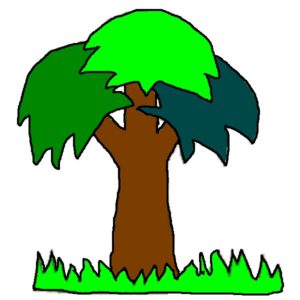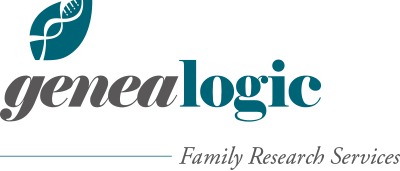Welcome to the GeneaLOGIC blog. Here you’ll find posts about genetic genealogy, stories from my own family and some of my clients (with their permission, of course), insights about lesser-known archives and documents, ideas for your own research, and more.

For my first post, I thought I would write about what it’s been like to be a genealogist with three branches on my family tree. If you’ve read the About page on this site, you know that two years ago my parents told me they had used a sperm donor to conceive me. In this post, I’m not going to write about my personal response to the news so much as my “genealogical” reaction. They’re related but distinct in my mind. Had I lost an entire branch of my family tree? Had I gained a branch? After years of researching both my mom’s and dad’s families, where did my family tree stand now that my true biological origins had been revealed?
One of the reasons my parents hadn’t told me they earlier that they had used a donor was precisely because I had become such a genealogy hound. “How were we to know we would get the genealogy kid?” my dad asked with exasperation during that first, most difficult conversation about the subject. And I get it. My obsessive hobby put them in a tough spot. Not only did I love my dad and my grandparents, but I was also quite attached to many of his — our — distant ancestors. Telling me they had used a sperm donor would, in a way, sever me from all of those people. My parents feared that my reaction would be much worse than it was.
To be sure, I have had to face that I am not biologically related to my dad’s family. I still mourn the loss a little bit, and not just for my dad himself. I lost biological relationships to early settlers in the New Sweden colony and to a rogue-ish New England heretic named Jonathan Singletary who upon his exile reinvented himself as the New Jersey miller Jonathan Dunham. I lost ties to Methodist preachers like Reverend Burgess Nelson, Revolutionary War veteran and Appalachian circuit rider Rezin Simpson, and abolitionist Illinois minister Abel Dunham. I no longer share genes with Palatine refugees who were part of the very first large-scale German immigration to America in 1709-10 or with Czech villagers who fled political retribution after the failed 1848 uprisings in Europe.
And yet, these families are in many ways my cultural legacy. Though I grew up in liberal Yankee-German-Scandinavian Minnesota, my closest family relationships besides my parents were with my grandparents in Nebraska. They were inheritors of a rural, more conservative midlands culture with roots farther east in Maryland, Pennsylvania, and Ohio. My grandma said “warsh” and “garsh.” She had no rhythm but still taught me how to polka. I attended a family reunion or two on my great-uncle’s big Nebraska farm (which he still operates). My grandfather was 100% Czech in ancestry. He took me to Czech Days in Wilber, Nebraska — self-proclaimed Czech capital of the U.S.A. He also took me flying over Nebraska’s endless cornfields in his Piper Colt. Together as a family, we drove a short distance to the Platte River in the early spring to watch the magical sandhill crane migration.
For all of these reasons, I still consider my dad’s family to be a full branch of my family tree. Even if I’m not biologically his son, I wouldn’t be here if he and my mom hadn’t decided to use a donor. My birth depended entirely on his (and my mom’s) desire to have me. There’s no sense in abandoning him or the impact his more distant family had on me as both a person and a genealogist.
All of that said, genealogist John was also excited by the news. Everybody has two main branches on their family tree. How many people get to have three?! I got to research an entirely new branch. (The hard part was figuring out where it fits in relation to the other two — but that’s the personal side of the story which I’ll leave for another time.)
At first glance, the donor’s ancestry wasn’t as exciting or diverse as my dad’s family. It’s almost entirely German Catholics who settled in central Minnesota during the late 19th century. I haven’t come across as many unexpected stories as I had found my dad’s side (suicides, accidents, stark moral decisions about slavery, etc.). One non-German line found its way into the tree, and it’s pretty neat. It goes back to New York Loyalists who chose to remain in the United States after the Revolution when some of their relatives moved to Canada. Further up that line are several families who arrived in the Massachusetts Bay colony during the 1640s to work in John Winthrop, Jr.’s iron works. They were among the earliest dedicated industrial workers in America (though calling it “industrial” a bit misleading, since their work looked nothing like the later factory system we’re used to). Even further back, my biological father descends from Alice Boleyn, aunt of the beheaded English Queen Anne Boleyn and one-time caretaker of both Queen Mary and Queen Elizabeth.
In summary, I have three full branches of my family tree, and I am fond of each of them in a different way. Each leaf on each branch represents a fascinating individual story. Together, they tell a fairly comprehensive history of America north of the 39th parallel. Perhaps most importantly, without any single person on any of the three branches, I would not be here today. Every family tree is quirky. In my case, I needed a third branch.

I have a relative on my late in -law’s side who may be related to Jos Vanek as listed in Ellis island immigration passenger document as age 15 ( occupation tailer) and travelling with ( prob sister) Marie vanek age 19 .
arrived Elis island 1883 , ship named Rugia ( no pict avail on that site)
passenger 9012326613987 ( marie’s) Frame 22,line 38
She married Leo ( or leon Check/chek/checknita ( variant spellings) and crossed in 1901 /1904 into Canada.
Lived out the rest of there lives with several children and grandchildren .
Cannot locate previous infomation on her life in the U.S. and thus cannot fgo further back ( origins). Not sure if related hence my writing to you to determine?